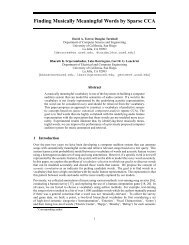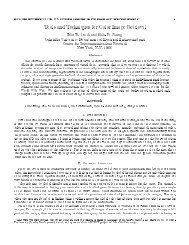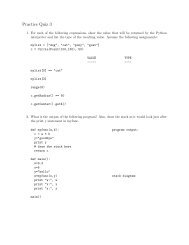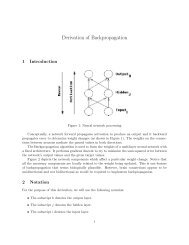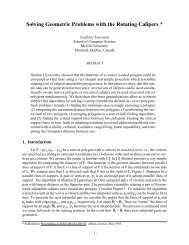Left-leaning Red-Black Trees - Princeton University
Left-leaning Red-Black Trees - Princeton University
Left-leaning Red-Black Trees - Princeton University
You also want an ePaper? Increase the reach of your titles
YUMPU automatically turns print PDFs into web optimized ePapers that Google loves.
<strong>Left</strong>-<strong>leaning</strong> red-black treesOur starting point is the Java implementation of standard BSTs shown in the gray code on the nextpage. Java aficionados will see that the code uses generics to support, in a type-safe manner, arbitrarytypes for client keys and values. Otherwise, the code is standard and easily translated to otherlanguages or adapted to specific applications where generic types may not be needed.In the present context, an important feature of the implementation is that the implementationof insert() is recursive : each recursive call takes a link as argument and returns a link, which isused to reset the field from which the link was taken. For standard BSTs, the argument and returnvalue are the same except at the bottom of the tree, where this code serves to insert the new node.For red-black trees, this recursive implementation helps simplify the code, as we will see. We couldalso use a recursive implementation for search() but we do not do so because this operation fallswithin the inner loop in typical applications.The basis of algorithms for implementing red-black trees is to add rotate and color flip operationsto this code, in order to maintain the invariants that dictate balance in the tree. Most publishedimplementations involve code laden with cases that are nearly identical for right and left. Inthe code in this paper, we show that the number of cases can be substantially reduced by:• requiring that 3-nodes always lean to the left (and that 4-nodes are balanced)• doing rotations after the recursive calls, on the way up the tree.The lean-to-the-left requirement gives a 1-1 correspondence between red-black and 2-3-4 trees andreduces the number of cases to consider. The rotate-on-the-way up strategy simplifies the code (andour understanding of it) by combining various cases in a natural way. Neither idea is new (the firstwas used by Andersson [2] and the second is used in [9]) but in combination they surprisingly effectivein reducing the amount of code required for several versions of the data structure. The codein black on the next page derives two classic algorithms by adding 3 lines of code to insert().Top-down 2-3-4 trees To insert a new node, we flip colorsto split any 4-node encountered on the way downthe tree and do rotations to balance 4-nodes (eliminateoccurrences of consecutive red links on the way up thetree). This approach is natural because splitting 4-nodesto ensure that the search does not terminate on a 4-nodemeans that a new node can be added by attaching it witha red link, and balancing a 4-node amounts to handlingthe three possible ways a red link could be attached to a3-node, as shown in the diagram at right. If the red linkthat is passed up happens to lean to the right in a 3-node,we correct that condition when we encounter it.rightrotateleftrotateflipcolorsPassing a red link up in a LLRB tree2-3 trees Remarkably, moving the color flip to the end inthe top-down 2-3-4 tree implementation just described yields an implementation for 2-3 trees. Wesplit any 4-node that is created by doing a color flip, passing a red link up the tree, and dealing withthe effects of doing so in precisely the same way as we move up the tree.These ideas are also effective for simplifying other variations of red-black trees that have beenstudied, which we cannot consider in this short abstract for lack of space. These include handlingequal keys, completing the insertion in a single top-down pass, and completing the insertion withat most one rotation in 2-3-4 trees.



